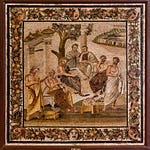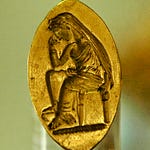3. Quintilian’s witness
It is often claimed that Quintilian’s description of the Latin accent is hampered or confused by the use of descriptive terms borrowed from Greek grammarians:
The Roman accent was a stress, while the Greek was a pitch accent … Roman grammarians borrow the Greek terminology and speak of accents in terms of pitch.1
And in a more recent Loeb edition:
The use of Greek terminology gave rise to considerable confusion and difficulty for the Latin grammarians, who have to use gravis for unaccented syllables, and acutus both for the tonic acute accent of Greek and for the stressed syllables of Latin.2
There are in fact three terms in Quintilian’s description of Latin prosody: ‘acute’, ‘flex’ and ‘grave’. The more recent editor does not even mention Quintilian’s use of ‘flex’, one presumes because he is embarrassed to impute to Quintilian the idea that Latin had a circumflex. He is also misleading about Quintilian’s use of gravis, as we shall see. It is thought that a sort of Greek envy, or emulation, guides Roman poetry and scholarship generally, in this case to the point of misrepresenting the Latin accent as though it were defined by a Greek-style pitch change.
These descriptors are indeed calques of the Greek terms ὀξύς, (περι)σπώμενον and βαρύς. The confusion, however, seems largely to be in the modern interpretation rather than the ancient author. A Latin theory of the contonation will be seen to vindicate Quintilian’s use of Greek terms, to describe completely homologous phenomena in Latin in a completely homologous way.
It will be shown in particular that Quintilian does not mean ‘unaccented syllables’ when he designates them as ‘grave’, but is using this term to describe specifically the svarita, the down-glide of the contonation that automatically follows the pitch rise. In this sense his description, applying Greek concepts in a correct way to describe Latin phenomena, may serve to correct the misdirection caused by the use of this term ‘grave’ in the notational practice of written Greek manuscripts, where it indicates by a downward angled sign the suppression of an acute, rather than a positive phonic feature in its own right.
In Greek grammar a whole class of words (heretofore pointlessly) were called ‘barytone’. Such a word is ἄνθρωπος; under the new theory, we describe this word as ‘barytone on the penult.’ The voice rises on the antepenult, as indicated by the acute sign, then falls in pitch over the two moras of the long penult. The prominent syllable according to Allen’s stress rules is this penult. Latin is supposed to stress a long penult, and for Quintilian this means it must bear the acute or the flex (e.g. anthrôpus). Quintilian cites a name of Greek origin that Latin speakers pronounce with apparent error in relation to Latin usage: Céthēgus. He cites other names of Greek origin that from his youth were pronounced with pitch rise on the antepenult, although the penult is long, whereas the Latin habit should yield Cethêgus. He also cites Cámillus, a Latin name that shows this prosody in pronunciation, where the Latin rule expects Camíllus.
The errors in question are described as switching acute and grave—as when Camíllus is pronounced acute on the first syllable, and so the penult switches from acute to grave—or switching grave for flex, as happens in the penult when Cethêgus is pronounced with initial acute. (Quintilian seems always to focus on the pitch pattern of the penult.) Translators err badly in this passage when they have Quintilian say that acute on the intitial syllable Céthegus causes the quantity of the middle syllable to change; they presume upon the text—there is no mention of quantity; the only change (mutatur, Inst. Orat. 1.5.23) the author is discussing in the passage is the change from one kind of accent to another, not long to short. The middle ‘e’ remains long, but is pronounced grave rather than flex.
It is in fact a salient feature of both classical Latin and Greek accentuation that the accented syllables do not affect the quantity or vowel grade of neighbouring syllables in pronunciation. (There is of course evidence that the historical initial stress in old Latin did produce these effects in unstressed syllables.) In this sense the alleged Latin ‘stress’ does not bring with it the usual most obvious effects of stress upon unstressed syllables, and by itself this suggests its nature may have more kinship with the pitch accent of Greek than is generally thought.
When Quintilian articulates the Latin accent rule, where the acute must occur within the last three syllables of a word (1.5.30-31), but never the last one, it is worth noting how he describes the case of a short penult: ‘a short syllable in this place will invariably have a grave accent, and so will make the syllable which precedes it (the antepenultimate) acute.’3 Note that a grave necessitates an immediately prior acute. This is an odd way of putting things if the story was simply that the acute located the stressed syllable in a word, and that all unstressed syllables are ‘grave’. Quintilian again focuses on the penult, or as he puts it, the middle syllable of the terminal three: whether this syllable is acute, flex, or grave, determines the accentual melody of the whole word. In point of fact, ‘grave’ cannot mean simply unstressed: Quintilian’s usage describes a prosodic phenomenon that is immediately, and necessarily, post-acute. The Greek borrowings can present the non-Latinate shape of a long penult that is all the same grave: that is, not ‘unaccented’, and neither acute nor flex (‘accented’), but grave post-acute. In this entire passage (Inst. Orat. 1.5.22-31), ‘grave’ therefore refers to the second part of the contonation when it occurs on its own syllable, rather than as part of the circumflex.
Quintilian’s description decides in favour of the first formulation of the Latin contonation rule:
In every word, the acute falls within three syllables, whether these are the only syllables in the word or the last three, and in these it is either on the penultimate or on the antepenultimate. Moreover, of the three syllables of which I speak, the middle, if long, will be either acute or circumflex; a short syllable in this place will invariably have a grave accent, and so will make the syllable which precedes it (the antepenultimate) acute.4
The formulation in terms of moras predicts that closed penults (where the vowel is ‘long by position’) will show pitch rise on the short vowel with the contonation completed within the syllable (círcus), and that naturally long penults will show the circumflex (mandâre). It seems clear that Quintilian excludes from native Latin the shape of Greek ἄνθρωπος, with rise on the antepenult and long svarita or grave on the penult, but remembers this shape from his youth in the pronunciation of certain Greek names in Latin (plus the name Cámillus!).
What emerges is that these three calques of terms from Greek grammar—acute, grave and (circum)flex—are in fact perfectly natural descriptors for the prosody of Latin, as suited for Latin as they ever were for Greek. This is because Latin also had natural quantity in its vowels and a recessive contonation, which results in these three possible effects when the contonation is placed in such a way as to be either disyllabic or monosyllabic. The key difference lies in the fact Quintilian points out: that the acute (the beginning of a contonation) is differently restricted in its recession than in Greek; it can never occur on the ultima, and because the circumflex contains an acute, neither can the circumflex land there except in the case of monosyllables. In Greek, the restrictions are on the number of moras allowed after the end of the contonation—that is, its immediately trailing βαρύς or svarita component—the feature Quintilian calls ‘grave’, ‘heavy’. Hence in Greek there are oxytone final words that can sound with enclitics, and perispomenon words (circumflex-final), neither of which can occur except in particular circumstances in Latin. Quintilian mentions grammarians who encourage pronouncing certain prepositions with acute-final accents, in the case of circum to avoid confusion with the noun (1.5.25-7), although he himself treats them as proclitics which lose their accent in favour of the accent of the word governed; he cites qui primus (qui prîmus) and ab oris (ab ôris) from line 1 of the Aeneid.
There is therefore no Greek envy going on here. In sharing the disyllabic contonation, and therefore being both tonal and quantitative, same as Greek, Latin is naturally suited to reinforcing Greek-style metres. Of course there is a level of abstraction involved, if these idiosyncratic metres were simply borrowed rather than grounded in traditional Roman dance practice. Some of the Greek metres had no doubt become classical forms rather than stimulants of a living jazz. But the German Mozart set new standards for Italian opera, and brought Italian coloratura to the German Magic Flute. Quintilian is not the least bit confused or filtered when he uses the terms acute, grave and flex to describe Latin prosody. Just as in Greek, this prosody in the classical period was genuinely tonal, and did not have the deleterious effects of stress on unstressed syllables.
As I mentioned, the prehistory of Latin does show direct evidence of the effects of stress; Quintilian’s contemporary forms show the evidence of an antique initial stress upon the following syllable, which persists in the spelling when the accent (mysteriously) became a recessive tonal prominence (e.g., ínimicus > *inamicus*). I maintain that there is something as yet unexplained about the emergence of this species of recessive, tonal accentuation across Greek, Latin and classical Sanskrit.
It is possible Quintilian gives us a snapshot that describes only the practice of his day, which may once have been different. He himself speaks about the pronunciation of Greek names that he heard from teachers in his youth, who performed the grave (svarita) on a long penult where the vetus lex, as he understood it, required a flex. Hence it is possible to wonder how old the old law really was, and if perhaps the practice in the era of Virgil, or in the idiomatic usage of Virgil, may have been different—perhaps more Greek in the sense that it was possible in some cases for the down-glide to occupy two moras. Quintilian, for example, declares solemnly that the heroic verse does not allow an iambus (1.5.29). And yet there is the third word of the Aeneid.
4. Virgil
In other writing I have already made the case for the prosody of canō. Let us now also add the Aeneid’s second word, virum—or virumque with its influencing enclitic. Both these disyllables are unheroic iambs, where the long final coincides with the thesis of the dactyl. The Latin rule stresses them as vírum and cánō, however, each accenting in context the second short of their respective dactyls, and leaving the ictus unstressed. This seems an unlikely effect to be intentional in the first line of the poem, for its very first phrase and cadence at mid-line. In the case of virumque one grammatical school allows that the enclitic causes the accent to shift to the ictus position, virúmque, but we are still left with cánō accenting the foot and line audibly out of place. I am well aware that there may be many educated modern generations used to pronouncing cáno here, from a distance beyond that of Quintilian’s barbarians. But the truth of the matter lies in the Latin contonation.
This is not to deny that Quintilian’s ‘old law’ is not old. It is rather to claim that Virgil’s hexameter, like Homer’s, was a locus of excepta for the sake of the music—Musae gratia. Iambic disyllables represent the only shape where recession of the acute portion of the contonation requires that the down-glide occupy a long syllable of two moras. It seems more than plausible that Virgil deployed such shapes for a rare ultima emphasis. The voice still rises on the short penult, but descends on pitch on the incantation of cánò, ‘I sing’.
The dispute about accentual shifts due to enclitics is also resolved by means of the Latin contonation: the idea that the accent does shift may have come precisely from examples like vírùmque, where the enlitic happens to close the final syllable of virum. This brings the grave down-glide into prominence, perceived as a shift in prominence from the preceding acute. Such a shift is indeed highly unlikely in cases like egomet and amāreve, cited by Gildersleeve and Lodge, which the disputed enclitic rule would stress as egómet and amāréve. The enclitics here do not change the equation of moras, however, and one should expect the old law applied to the whole collocation, in these cases causing no shift: égomet and amáreve. (In the latter case, however, we see perhaps a change from flex to acute, amâre + ve = amáreve.) In this way, analysing in light of the contonation, as I would claim does Quintilian, helps explain an occasional accentual shift caused by enclitics in a completely straightforward way.
There follows a suggested performance text for the opening of Virgil, using acutes for the pitch rise of the contonation and for short vowels in closed syllables, circumflexes for the contonations completed within long vowels, and graves written to follow acutes only on the rare occasions when they are more prominent than the acutes in Virgil. One rediscovers a pattern, familiar to the method from Homer, of syncopation yielding to moments of agreement, but with all the nasalisations and falling cadences of Latin.
Árma vírùmque cánò, Troîae qui prîmus ab ôris
Itáliam, fâto prófugus, Lavíniaque vênit
lítora, múltum ílle et térris iactâtus et álto
vî súperum saêvae mémorem Iunônis ob îram;
múlta quoque et béllo pássus, dum cónderet úrbem,
inférrètque déòs Látio, génus únde Latînum,
Albánìque pátrès, atque áltae moénia Rômae.
Harold Edgeworth Butler, Quintilian. With an English Translation, Cambridge: Cambridge University Press, 1920.
Footnote to translation of Quintilian, Institutio Oratoria, 1.5.22-33, tr. Donald A. Russell, Quintilian: The Orator’s Education, Books 1-2, Cambridge, MA: Harvard University Press, 2001, 135.
tr. Russell.
Ibid.; Inst. Orat. 1.5.30-1.















Vindicating Quintilian: Latin Has A Pitch Accent!